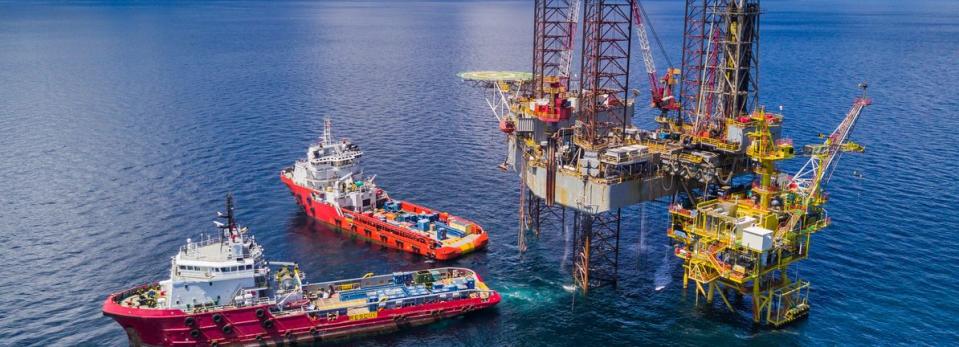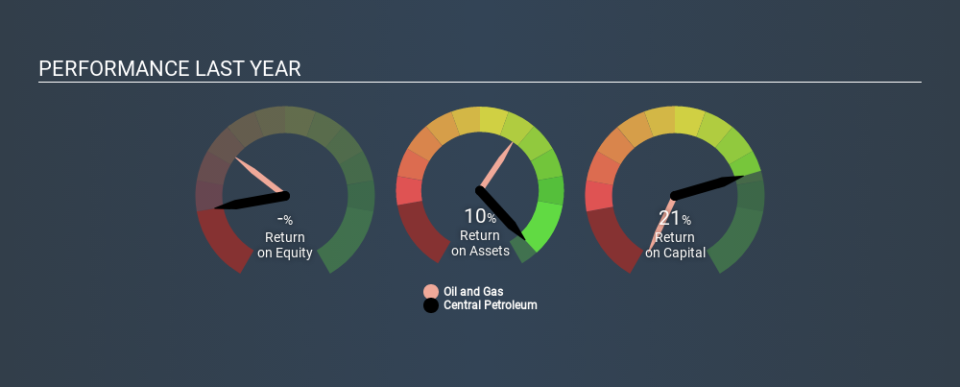Are Central Petroleum Limited’s (ASX:CTP) High Returns Really That Great?

Today we'll evaluate Central Petroleum Limited (ASX:CTP) to determine whether it could have potential as an investment idea. Specifically, we'll consider its Return On Capital Employed (ROCE), since that will give us an insight into how efficiently the business can generate profits from the capital it requires.
Firstly, we'll go over how we calculate ROCE. Then we'll compare its ROCE to similar companies. And finally, we'll look at how its current liabilities are impacting its ROCE.
What is Return On Capital Employed (ROCE)?
ROCE measures the 'return' (pre-tax profit) a company generates from capital employed in its business. All else being equal, a better business will have a higher ROCE. Overall, it is a valuable metric that has its flaws. Renowned investment researcher Michael Mauboussin has suggested that a high ROCE can indicate that 'one dollar invested in the company generates value of more than one dollar'.
How Do You Calculate Return On Capital Employed?
Analysts use this formula to calculate return on capital employed:
Return on Capital Employed = Earnings Before Interest and Tax (EBIT) ÷ (Total Assets - Current Liabilities)
Or for Central Petroleum:
0.21 = AU$15m ÷ (AU$163m - AU$93m) (Based on the trailing twelve months to December 2019.)
So, Central Petroleum has an ROCE of 21%.
Check out our latest analysis for Central Petroleum
Is Central Petroleum's ROCE Good?
One way to assess ROCE is to compare similar companies. In our analysis, Central Petroleum's ROCE is meaningfully higher than the 7.4% average in the Oil and Gas industry. I think that's good to see, since it implies the company is better than other companies at making the most of its capital. Setting aside the comparison to its industry for a moment, Central Petroleum's ROCE in absolute terms currently looks quite high.
Central Petroleum delivered an ROCE of 21%, which is better than 3 years ago, as was making losses back then. That suggests the business has returned to profitability. You can click on the image below to see (in greater detail) how Central Petroleum's past growth compares to other companies.
When considering ROCE, bear in mind that it reflects the past and does not necessarily predict the future. Companies in cyclical industries can be difficult to understand using ROCE, as returns typically look high during boom times, and low during busts. ROCE is, after all, simply a snap shot of a single year. Given the industry it operates in, Central Petroleum could be considered cyclical. What happens in the future is pretty important for investors, so we have prepared a free report on analyst forecasts for Central Petroleum.
What Are Current Liabilities, And How Do They Affect Central Petroleum's ROCE?
Liabilities, such as supplier bills and bank overdrafts, are referred to as current liabilities if they need to be paid within 12 months. The ROCE equation subtracts current liabilities from capital employed, so a company with a lot of current liabilities appears to have less capital employed, and a higher ROCE than otherwise. To counter this, investors can check if a company has high current liabilities relative to total assets.
Central Petroleum has total assets of AU$163m and current liabilities of AU$93m. As a result, its current liabilities are equal to approximately 57% of its total assets. Central Petroleum's high level of current liabilities boost the ROCE - but its ROCE is still impressive.
Our Take On Central Petroleum's ROCE
In my book, this business could be worthy of further research. Central Petroleum looks strong on this analysis, but there are plenty of other companies that could be a good opportunity . Here is a free list of companies growing earnings rapidly.
Central Petroleum is not the only stock that insiders are buying. For those who like to find winning investments this free list of growing companies with recent insider purchasing, could be just the ticket.
If you spot an error that warrants correction, please contact the editor at editorial-team@simplywallst.com. This article by Simply Wall St is general in nature. It does not constitute a recommendation to buy or sell any stock, and does not take account of your objectives, or your financial situation. Simply Wall St has no position in the stocks mentioned.
We aim to bring you long-term focused research analysis driven by fundamental data. Note that our analysis may not factor in the latest price-sensitive company announcements or qualitative material. Thank you for reading.

 Yahoo Finance
Yahoo Finance 
